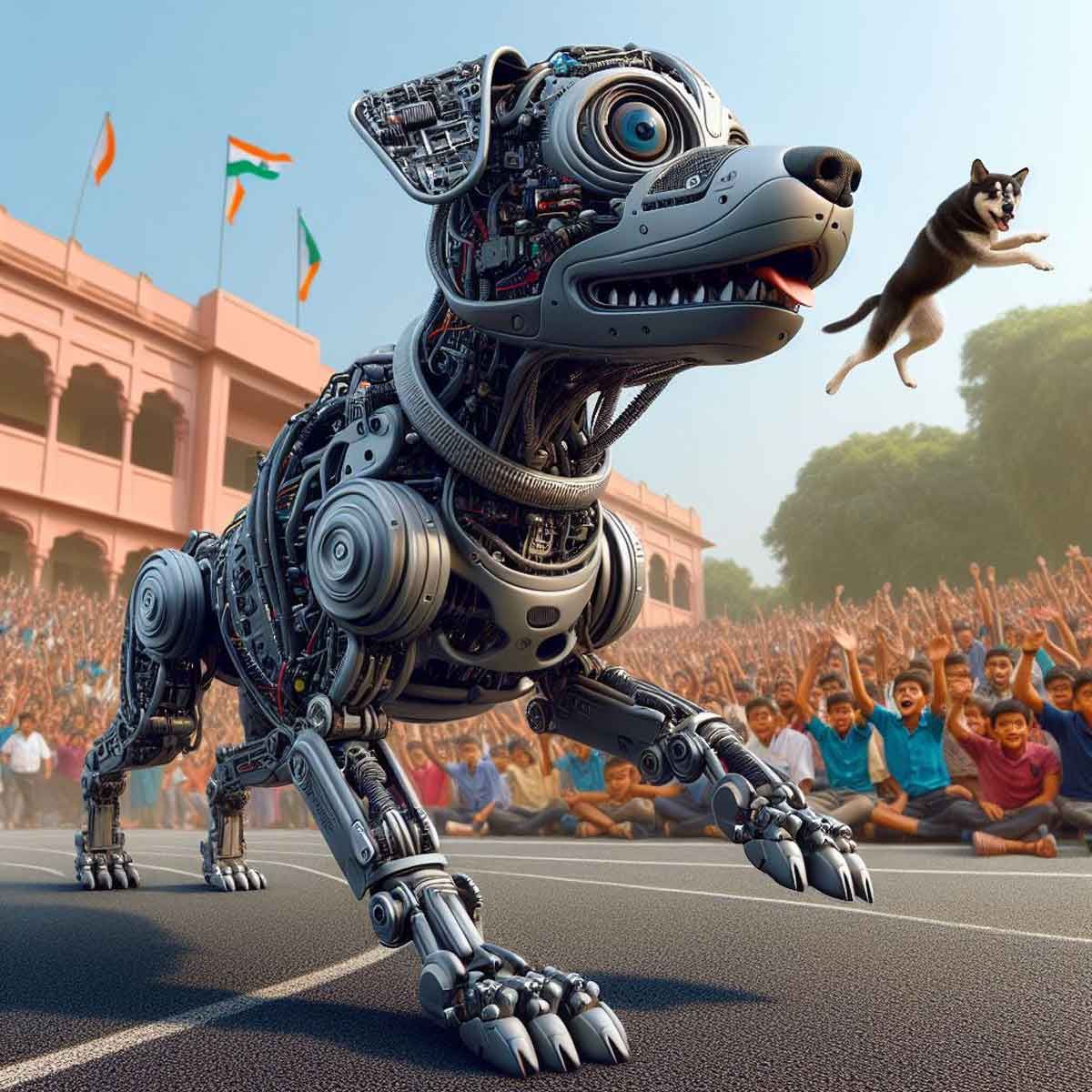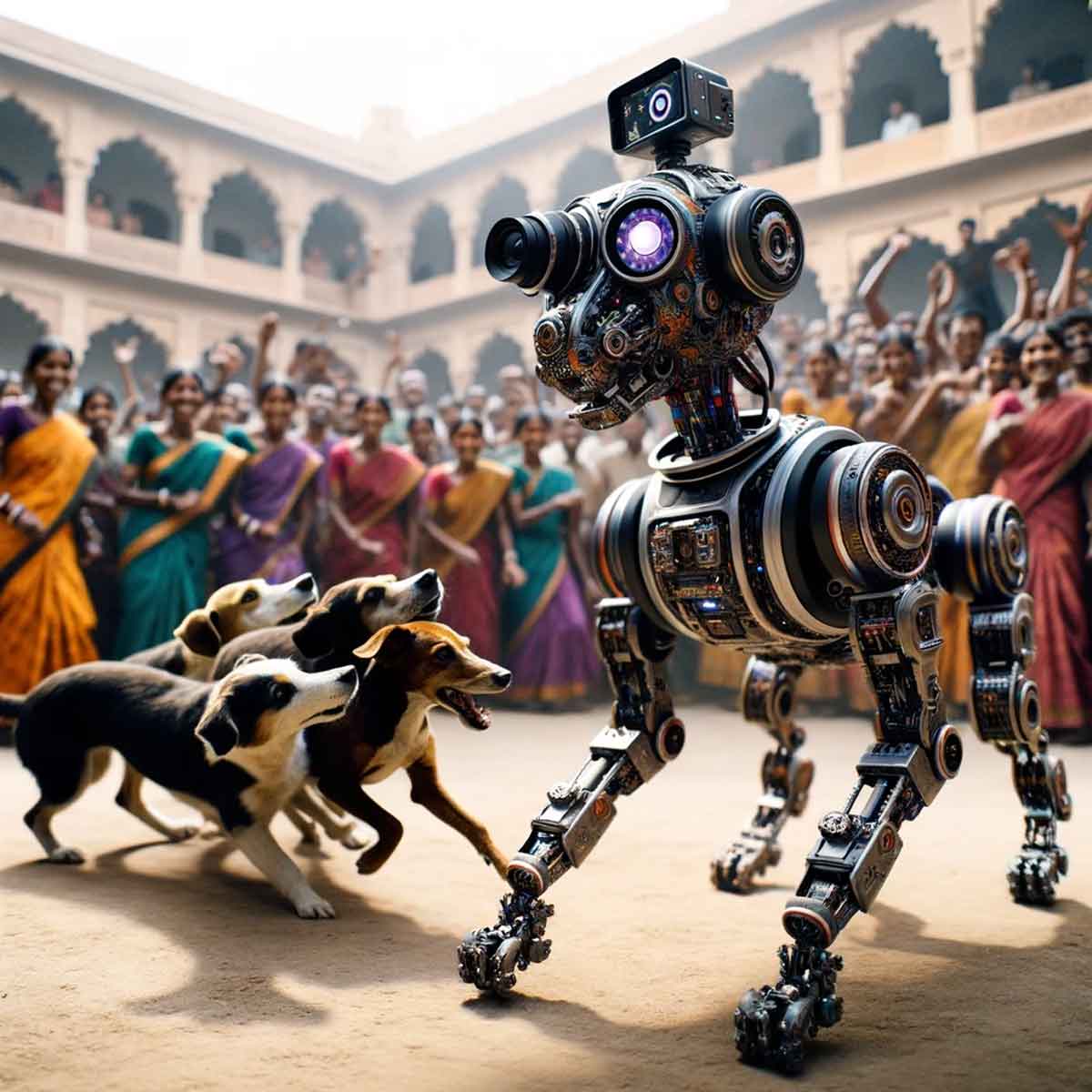More Coverage
Twitter Coverage
Satyaagrah
Written on
Satyaagrah
Written on
Satyaagrah
Written on
Satyaagrah
Written on
Satyaagrah
Written on
JOIN SATYAAGRAH SOCIAL MEDIA
In a world where robots fetch more, even the canniest of canines find themselves in a tail-wagging contest of wits & whimsy; Muks Robotics rolls out the red carpet for AI, sparking a playful rivalry that leaves every dog wondering who's really the top dog

In our rapidly evolving world, robots are increasingly becoming a common sight, seamlessly integrating into various sectors and revolutionizing the way tasks are performed. From executing simple chores to handling complex operations, the realm of robotics has expanded significantly, especially over the last ten years. A recent incident at the Indian Institute of Technology (IIT) Kanpur perfectly illustrates the fascinating intersection between advanced robotics and everyday life, capturing the hearts of many on social media.
|
The incident involved a stray dog's first encounter with a robot dog, a moment that was both endearing and amusing. A video of this encounter quickly went viral, showcasing the natural curiosity and playful behavior of the canine towards its mechanical counterpart. In the footage, viewers can see the stray dog cautiously, yet eagerly, circling around the robot dog, seemingly trying to understand what it was. Despite some initial hesitation, the dog attempts to interact with the robot dog in a playful manner, mirroring its movements in a dance of curiosity and technological marvel. This scene was not just limited to the one dog, as other local canines also joined in, intrigued by the new 'member' that had suddenly appeared in their territory.
This remarkable robotic dog was crafted by Muks Robotics, as indicated by the video's text overlay. The amusing and heartwarming encounter was aptly titled "Funny incident happens with robot dog vs real dog," as shared on Instagram by Dr. Mukesh Bangar, the Founder and CEO of Muks Robotics. This unique moment was captured amidst the festivities of IIT Kanpur's tech fest, 'Techkriti'.
Techkriti, now in its 30th year, is a four-day festival that took place from March 14th to March 17th. Renowned for being a significant technical and entrepreneurial event, this year's theme was aptly named "The Cosmic Nexus." The festival boasted a plethora of competitive events across a wide range of domains such as Robogames, Take Off, Software Corner, Mandakini, Model United Nations, Fintech, ECDC, Design, and Technovation. Each event was designed to challenge and inspire the minds of participants, encouraging innovation and technological advancement.
The video capturing this unique encounter became a hot topic among internet users, sparking a wide array of reactions. The audience was primarily fascinated by the seamless integration of cutting-edge technology into the fabric of reality, a feature that many applauded, attributing it to India's progress in the robotics arena.
The range of comments left by viewers showcased a blend of amusement and contemplation over the implications of such technological advancements. For instance, one viewer humorously speculated about the robot dog's potential difficulty in convincing its peers of its experiences, saying, "He'll go back and tell his friends but they won't believe his story!" This remark points to the surreal nature of witnessing technology that seems to leap from the pages of science fiction into our everyday lives.
Another viewer succinctly captured the essence of the moment with the comment, "Science meets reality." This observation reflects a growing awareness and appreciation of how far technology has come, to the point where its applications are not just theoretical but have real-world interactions and implications.
The discussion also veered into speculative territory regarding the future of employment and roles within society, even extending to animals. One commenter, perhaps with a hint of jest or underlying concern, noted, "Even the dogs are getting replaced in future." This was closely followed by another user who remarked on the expanding reach of artificial intelligence (AI) by saying, "Tragic, AI is taking dog's jobs too." These comments underline a broader dialogue about the displacement of traditional roles and jobs in the face of relentless technological progress.
Adding a cinematic flavor to the conversation, another individual drew parallels with popular science fiction by describing the robot as a "Terminator dog" and evoking the iconic 'Judgement Day' scenario. "He is like, that's a Terminator dog. Judgement day is coming," they said, imbuing the discussion with a sense of awe and a touch of apprehension about the potential power and unpredictability of AI.
Muks Robotics
Muks Robotics stands at the forefront of technological innovation, dedicating its expertise to crafting AI-powered autonomous robots. These machines are not just marvels of engineering; they're designed with a noble purpose: to alleviate human pain and suffering. The company has proudly unveiled its flagship products, the Muks® B1 AGI NPU and Spaceo™, setting a new standard in the realm of robotics as mainstream solutions.
Behind this revolutionary venture is Dr. Mukesh Bangar, the brainchild of Muks Robotics. Dr. Bangar is not your typical engineer; he's a self-made maestro in AI and robotics, having unravelled the complexities of Artificial Consciousness, Natural Learning, and Neural-network based motor actions. His journey from a passionate enthusiast to the founder and lead developer of Muks Robotics is a testament to his vision and dedication to advancing robotics technology.
The narrative of industrial robotics has been a fascinating saga of evolution and innovation. Looking back at Robotics 1.0, the era spanning the 1960s to the 1980s, robots were in their infancy, possessing minimal awareness of their environment. This limitation necessitated reliance on waypoint teaching for executing repetitive, mundane, and physically demanding tasks. The pioneering technologies of this period—servo motors, controllers, and motor drives—laid the groundwork for the robots of tomorrow. The control mechanisms of early prototypes, such as Verst from Am and Animate from Animation, mirrored those of numerical control machines, albeit with distinct mechanical configurations.
Transitioning into Robotics 2.0, the landscape underwent a dramatic transformation thanks to the widespread adoption of information gathering and computing technologies. This era, spanning the 1990s to the 2000s, saw the emergence of automatic systems equipped with feedback capabilities, propelling the development of industrial robots across a broader spectrum of manufacturing applications. Innovations such as force/torque sensors, vision systems, Ethernet, embedded and real-time systems, data acquisition, and signal processing were at the heart of this technological leap.
The current phase, Robotics 3.0, represents a pinnacle of integration and exploration, where large-scale real-time image recognition, scene understanding, vocal communication, deep learning, and natural human-robot interactions, among others, dominate. This era, also dubbed the 'Big Bang' of robotics, heralds an age of custom and cloud manufacturing, driven by a plethora of enabling technologies including natural language processing for human-robot interaction, deep learning for scene comprehension, and digital twinning for cyber-physical systems. Starting in the 2010s and poised to evolve into Robotics 4.0 in the early 2020s, this stage is characterized by disruptive technologies such as the internet of robots, Brain-on-Cloud (BoC), Artificial Intelligence of Things (AIoT), home robot assistants, the deployment of 5G for robotic applications, and the seamless integration of cognitive skills in robots to fulfill both industrial and societal needs.
Muks Robotics, through its innovative creations and Dr. Bangar’s visionary leadership, is not just participating in this technological revolution; it is actively shaping the future of robotics, demonstrating a commitment to enhancing human life and pushing the boundaries of what robots can achieve in society.
Application of Robotics in Industry 4.0:
The advent of the Industrial Revolution, notably referred to as Industry 4.0, promises to usher in an era of unprecedented standards of living and spur global economic growth. A hallmark of this era is the collaborative synergy between humans and robots, facilitated by advanced smart sensor human-machine interfaces. This collaboration is epitomized by autonomous robots, which are becoming increasingly prevalent across various manufacturing sectors. The multifaceted applications of robotics in Industry 4.0 are profound and diverse, as discussed below:
In Manufacturing:
The manufacturing sector faces numerous challenges, particularly regarding labor costs and skill shortages. Automation emerges as a viable solution to these issues. For example, in the automotive industry, where heavy lifting is often required, robotic devices can significantly alleviate the physical strain on workers. This is a quintessential example of Industry 4.0, where the concept of the "Smart factory" comes to life. A smart factory represents a leap in manufacturing technology, where automation is just the beginning, and all equipment is digitally interconnected within a unified system. This digital interconnectivity allows for real-time monitoring and control of physical processes. Additionally, robot-based inspection systems, leveraging vision technology, play a crucial role in flaw detection and ensuring accurate part assembly.
Autonomous Vehicles:
As the global population grows, so does the concern over road safety and the increasing incidence of accidents. Autonomous vehicles, utilized across various domains such as manufacturing, mining, agriculture, logistics, and transportation, offer a promising solution. These vehicles, particularly Automated Guided Vehicles (AGVs), are instrumental in optimizing material transport to warehouses, marking a shift from mere automation to intelligent system operation within the context of the fourth industrial revolution.
In Health Care:
Robotics holds transformative potential in healthcare, from drug compounding to enhancing operator safety, cost-efficiency, and quality. Before any physical intervention, emerging technologies enable the training of operators and optimization of production. The advent of error-free robots, capable of performing tasks like aseptic fill-finish where human error could compromise expensive drug batches, is revolutionary. The AURA Robot, an evolution of traditional robotics, incorporates standard state machines alongside automatic and remote modes, further subdivided into three non-selectable states. Robotics also facilitates precise surgeries, reducing costs for patients, and allows for the safe handling of harmful chemicals, thereby improving operational efficiency.
In Packaging:
The latest generation of robotic systems, coupled with advancements in data flow, is redefining packaging production. It enables an integrated approach that encompasses design, production, distribution, and maintenance. Robotics is making significant impacts in converting and distribution, with the food packaging industry benefiting greatly. Robots enhance productivity, handling efficiency, picking, placing, packing, and palletizing. They are programmed for precise food quantity in packaging modules, a task less feasible with human workers, thus boosting efficiency and productivity.
In Mining:
The mining industry is leveraging robotics and current technology to enhance exploration and operation. Robot-operated drills allow for deeper terrestrial exploration, while detailed mine surveys are conducted with robotic assistance. Autonomous vehicles and drones are employed for inspecting oil and gas lines in inaccessible areas, exemplified by Schlumberger's use of autonomous underwater vehicles for sub-sea condition inspections, requiring no local team support.
Military and Public Safety Industry:
Technological advancements have significantly transformed the military and public safety sectors. Drones and robots are deployed for battlefield support, surveys, and guard duties, equipped with ample battle materials and environmental sensing capabilities for autonomous attack operations. In public safety, remote-controlled drones provide real-time situational analysis and monitor hazardous conditions, aiding in risk assessment and management.
Supermarkets and Malls:
Retail giants like Walmart are embracing automated technology and robotics for inventory management and floor cleaning. These machines, equipped with sensors, can detect human presence, assist in-store shopping, help customers locate products, and retrieve items from unreachable shelves, enhancing the shopping experience.
Agriculture:
Agriculture benefits from self-driving tractors equipped with guidance systems for optimal fertilizer application. Soil condition sensors provide valuable data for crop management, illustrating the practical application of robotics in enhancing agricultural productivity.
3D Printing and Furniture World:
Ashley Furniture is harnessing robotics and 3D technology to revolutionize furniture production. By creating necessary small parts in-house and utilizing 3D printing, Ashley is adapting to a low labor market while expanding its production capabilities.
Robots in Music:
The Georgia Institute of Technology has made a significant contribution to the music world with 'Shimon,' a four-armed robot capable of listening, improvising, and performing alongside human musicians. Led by Gil Weinberg of Georgia Tech's Center for Music Technology, Shimon represents 12 years of research aimed at augmenting human creativity with robotics. Shimon can learn from music theory, notes, and styles, enhancing musical performances with unique chord structures beyond human capability.
The applications of robotics in Industry 4.0 are wide-ranging, touching upon manufacturing, transportation, healthcare, packaging, mining, military, retail, agriculture, furniture
 |
 Support Us
Support Us
Satyagraha was born from the heart of our land, with an undying aim to unveil the true essence of Bharat. It seeks to illuminate the hidden tales of our valiant freedom fighters and the rich chronicles that haven't yet sung their complete melody in the mainstream.
While platforms like NDTV and 'The Wire' effortlessly garner funds under the banner of safeguarding democracy, we at Satyagraha walk a different path. Our strength and resonance come from you. In this journey to weave a stronger Bharat, every little contribution amplifies our voice. Let's come together, contribute as you can, and champion the true spirit of our nation.
 |  |  |
| ICICI Bank of Satyaagrah | Razorpay Bank of Satyaagrah | PayPal Bank of Satyaagrah - For International Payments |
If all above doesn't work, then try the LINK below:
Please share the article on other platforms
DISCLAIMER: The author is solely responsible for the views expressed in this article. The author carries the responsibility for citing and/or licensing of images utilized within the text. The website also frequently uses non-commercial images for representational purposes only in line with the article. We are not responsible for the authenticity of such images. If some images have a copyright issue, we request the person/entity to contact us at This email address is being protected from spambots. You need JavaScript enabled to view it. and we will take the necessary actions to resolve the issue.
Related Articles
- "Cyberspace undeniably reflects some form of geography": Ashwini Vaishnaw launched "Bharat 6G Alliance" for better collaboration between Govt, industry and academia in developing indigenous 6G products, India already has 200+ patents for 6G
- Ten most compelling evidence of Extraterrestrial existence from 2020
- "Research is creating new knowledge, without which there is no progress": National Research Foundation - a visionary initiative by the Indian govt aimed at centralizing funding for scientific & academic research with an ambitious target of ₹50,000 crore
- "Magic is the projection of natural energies to produce needed effects": The Elixir of Life: How Uravu Labs extracts drinking water from Air, with a current installed capacity of 1k litres/day, Uravu plans to scale to 1 Lakh litres/day by next 2 years
- ISRO successfully tested the Gaganyaan Service Module Propulsion System (SMPS) on July 19, 2023 at ISRO Propulsion Complex (IPRC) , Mahendragiri
- "And the winds and the waves are always on the side of the ablest navigators": ISRO successfully launched GSLV-F12/NVS-01 Mission from SDSC-SHAR, Sriharikota, NVS-01 first of the India's second-generation NavIC satellites that accompany enhanced features
- "If art is to have a special train, the critic must keep some seats reserved on it": In a momentous event, PM Narendra Modi flagged off Puri-Howrah Vande Bharat Express in Odisha, marking a significant milestone in India's railway infrastructure evolution
- "Global trust, local talent: India's invitation to the semiconductor world": PM Modi announces that India's moment has arrived in the semiconductor, Global leaders unite in praise as India gets ready to take center stage in the semiconductor industry
- “Genius is never understood in its own time”: Do you know when you put your debit card in ATM and ask for money, machine arranges the money before giving it to you using Srinivasa Ramanujan’s partition theory, celebrated as National Mathematics Day
- "Beyond gravity, within safety": ISRO's Gaganyaan mission progresses with Drogue Parachute tests, prioritizing astronaut safety, aiming to send a crew to 400 km orbit for 3 days, it utilizes Human Rated LVM3 and comprehensive training in Bengaluru
- "Research is formalized curiosity. It is poking and prying with a purpose": Full-sized digital scan of the Titanic, which lies 3,800 m (12,500 ft) down in the Atlantic, has been created using deep-sea mapping, providing a unique 3D view of the entire ship
- "Driving the future, pod by pod": IIT Madras' Avishkar Hyperloop team is spearheading a transportation revolution, with global accolades, a prototype in place, & national backing, they're not just envisioning, but shaping future of rapid transit in India
- "Ability is Prabhu-given, prowess is earned": New Generation Ballistic Missile Agni Prime successfully flight tested by DRDO on 7th June from Dr APJ Abdul Kalam Island off the coast of Odisha, all the objectives of flight test successfully demonstrated
- "Innovation is the calling card of the future": Jaldost, a revolutionary airboat by Bengaluru's National Aerospace Laboratories, powers through aquatic weeds, carving the path towards preserving cleaner water bodies, a testament to indigenous innovation
- India embarks on a transformative journey, aiming to launch its first semiconductor chip in Dec 2024 & to inaugurate a cutting-edge bullet train by 2026 under PM Modi's ambitious vision for technological self-reliance and the unification of economic zones




























